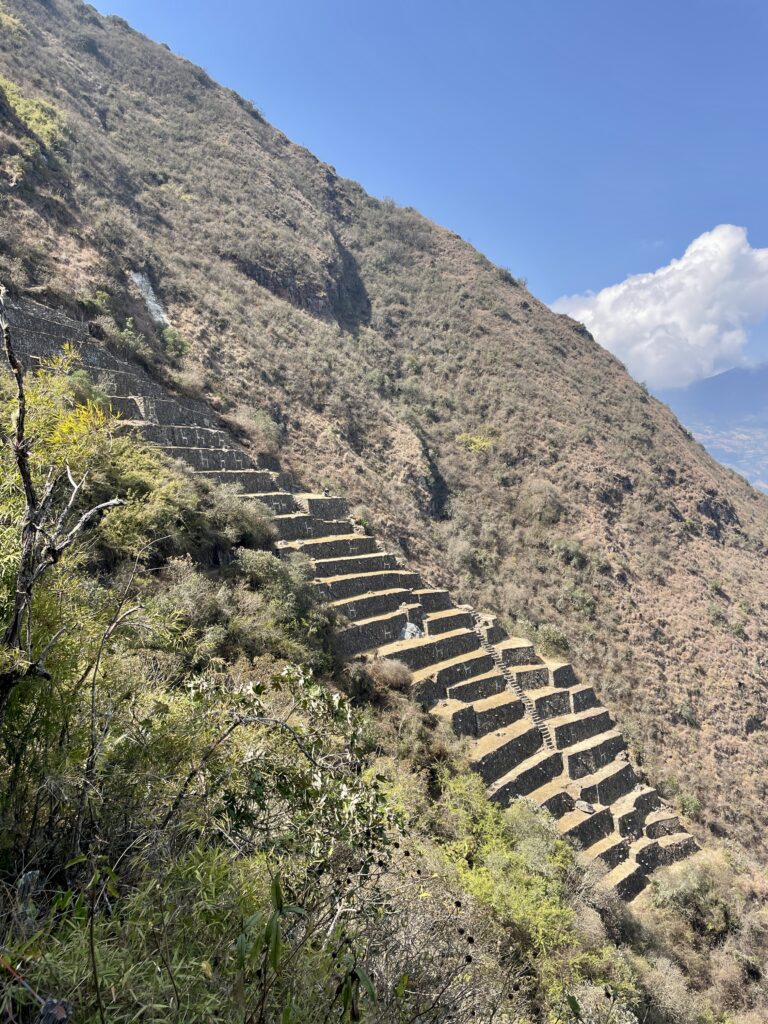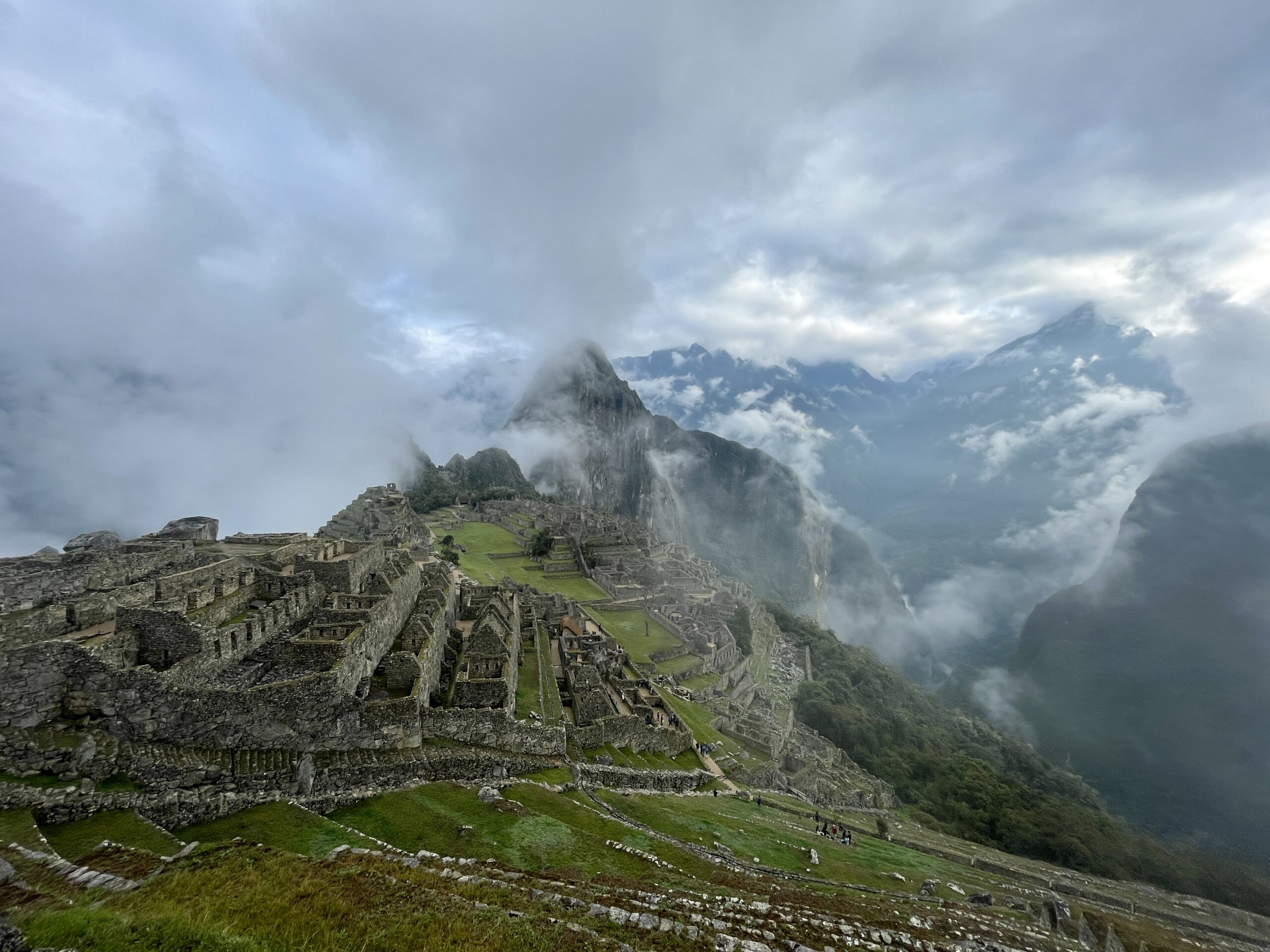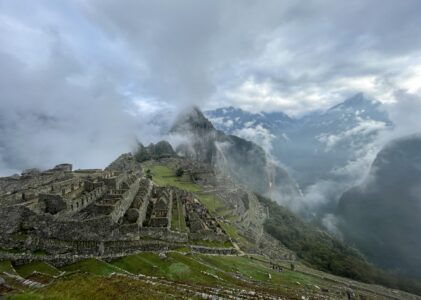Who looked at this landscape and thought, let’s build a trail through here?!
We could see the trail winding its way up the other side of the impossibly steep slope, close enough in the horizontal plane that we felt we could almost reach out and touch it. The only problem being: the 1500m chasm that lay between us and the trail on the other side.
After our unplanned extended stay in Cusco due to illness, we’d settled on a walking link up of the Inca sites at Choquequirao and Machu Picchu as a good way of getting back into the swing of daily physical activity, without overly taxing our bodies with the daily 5000m passes that had constituted most over our riding on the Peru Divide. As the intro to this post suggests, it wasn’t quite the gentle introduction that we’d naively been hoping for, but 9 days later and back in Cusco, we’re both fully agreed that it was absolutely the right thing to do; the different pace that walking necessitates was a welcome relief from our well established routines on the bike, the scenery was unlike anything we had experienced in Peru so far and, to top it off, we got to visit two amazing, yet very different, Inca ruins.










At this point, my camera battery ran out. En route to see the seventh wonder of the world and no working camera! Some expletives may have been uttered. As such, the remaining photos in this post all come from El’s iPhone.
From the Apurimac, we climbed 500m up to the Santa Rosa Bajo campsite where, even though it was only 2pm, we decided to call it a day. Our legs were pretty trashed from the 1500m straight downhill and this was supposed to be a gentle re-introduction to exercise after all. The campsite was surrounded by avocado trees (we managed to blag 3 avocados from the camp guardian for our onward journey) and not as buggy as we had feared. It was as good a spot as any to spend an afternoon snoozing and reading books.



One of the great things about Choquequirao is that you can camp on site, which is handy given how large an area the site occupies. Another big positive for us was how few visitors this site gets – roughly 30 per day – no doubt that tough 2 day walk in playing its part. That evening, we shared the campsite with a couple of Limeños we’d been hopscotching with all day and a couple from Denmark on a full donkey/chef/guide package. For a moment, we looked longingly down on their camp as they tucked into their 3 course meal whilst we ate out usual pasta and tinned fish, but in the end decided that we’d both feel awkward with 3, obviously much poorer than us, people waiting on us hand and foot.
We spent the following morning walking between the different areas that make up the site. With only us and the Danes around, it felt like a very personal experience, far removed from the mass tourism that infects most of the Inca sites close to Cusco.



As we made our way up to Usnu, the high point of the site, the clouds cleared to reveal the Plaza Principal bathed in sunshine.







The highlight of any visit to Choquequirao has to be the Andenas de Llamas (Llama terraces), which sit nearly 400m below the Plaza Principal, clinging to the precipitous hillside. It’s quite incredible how much effort the Incas went to in order to create just a few square metres of productive land. It has to be seen to be believed.





We climbed back up the terraces using the steps instead of the tourist path which was mildly terrifying (each step being half a foot deep and a foot tall), both agreeing that there could’ve been no place for vertigo sufferers in Incan society.
Instead of returning back to Cachora as is the usual way to visit Choquequirao, we continued North towards the village of Yanama, a further 2 days away. If anything, the path on this stretch was even more spectacular than on the way in; steeper, narrower and with even fewer people.





We camped that night on some partially excavated terraces, joined again by the Danes and their entourage. Chatting to the porters that evening, they said that the terraces go right down to the valley bottom, a height difference of over 1000m. What a sight it must have been to see these terraces back in the days when they were fully productive!


The following 2 days were spent first dropping down to the Rio Blanco, then tackling the 2000m+ climb up to Passo San Juan at 4100m, before dropping back down to Yanama.







From Yanama, we decided to gain a day by taking a collectivo over the big hill into the Santa Teresa valley and the Salkantay trail. The only catch being that it left at 4:30am! The contrast between the hordes of the Salktantay trail and the blissful peace we’d experienced over the previous two days was stark – for sure, we would recommend doing the Choquequirao walk to get to Machu Picchu over Salkantay if you’ve got a few more days and are up for a harder, more remote walk.
We spent that last night on the “trail” in Llactapata Lodge enjoying two delicious meals (pasta and tinned fish getting quite old by this point), with a camp pitch overlooking Machu Picchu. We had another early start the following morning to tackle the train tracks to Aguas Calientes and hopefully get a good spot in the queue to buy our Machu Picchu tickets.

Aguas Calientes was a nightmarish place, full of overpriced tat and tourists queuing for the bus up the hill. The whole place reminded me of that South Park episode where the town gets overrun by pan pipe bands busking for money! After collecting our ticket to get our spot in the queue (numbers 117 and 188 out of 1000), we spent the early afternoon drying our tent our in a park, dirtbag style. To be fair, after some initial chaos in the main square where the woman announcing the ticket numbers struggled to compete with a brass band and parade happening simultaneously, the process to get our actual tickets to visit Machu Picchu was smooth and relatively stress free. We even had chairs to sit on as we queued! The early start had been worth it as we managed to get the tickets we wanted: circuit 2 at 6am. We escaped back down the road to the municipal campsite as soon as we could, thankful never to have to revisit Aguas Calientes.
Another early start beckoned. At 5am, we were gathered at the entrance bridge in the drizzle with a handful of other hardy souls who would be hiking up the trail and hoping to beat the first bus to the entrance. This, we just about managed and found ourselves standing about 5th or 6th back in the queue to get in. When the gates opened, we quickly passed the alumni reunion from Browns in front of us and had what had felt like a hopelessly optimistic dream: Machu Picchu almost to ourselves!
Some waiting was required to let the early morning mist blow through, but our patience was rewarded as we got a brief glimpse of “the view” before the clouds descended again. The weather would stay moody all morning, making the whole place feel even more ethereal and otherworldly than it otherwise would have – better than a bluebird day we both agreed.


After ticking the postcard view off the list, we walked around the rest of the site pretty much alone for the most part. What I think impressed us both was the shear density of structures in such a small area, and how creative the Incas had been in building these structures on and around the natural terrain. The whole place is a maze of nooks and crannies, so different to the boring grids that most modern Peruvian towns seem to be built on.





















After 3 hours spent ogling the stonework and posing in doorways, we descended back down the million steps to the Rio Urubamba (this time in daylight) and retraced our steps back along the rail tracks to Hidroeletrica where a tourist minivan awaited us for the 6 hour drive back to Cusco (urgh).
In the lead up to this excursion, El had taken great please in asking everyone we met who had visited both Choquequirao and Machu Picchu which one they preferred. An impossible question that they unsurprisingly struggled to answer. Both sites are unique a special in their own ways; Choquequirao for its superlative location, quietness and the incredible Llama terraces, Machu Picchu for its limitless intriguing buildings and how well it has been preserved. We were both every glad that we’d made the decision to visit both, and link them by walking on the same paths that the Incas would have down over half a millennia ago.
If you’re interested in learning more about the Inca and other fallen civilisations then we would recommend this podcast which has done the rounds of the bike tourists. It’s 3h long but that is nothing when you’re climbing 5000m passes every day!
Routes
If you’re interested in our routes, you can find them all on our trip homepage.


I enjoyed your post. Enjoy Bolivia. Thanks
Fabulous post. That walk has definitely gone on my bucket list.
Do it while you still can!
Really impressed with what you two are doing Liam. What a journey. Travelled a bit in South America myself and hats off to you guys; especially with stomach bugs thrown in the mix. Keep posting!